GIGABYTE BRIX Pro: A First Look at the Intel i7-4770R with Iris Pro HD 5200
by Ganesh T S on January 7, 2014 8:00 PM EST
Gigabyte is targeting the BRIX Pro towards professional consumers with compute-intensive workloads. For general office use (including web browsing and light word processing work), systems such as the Core i5-based NUC we reviewed last week are more than enough. In order to bring out scenarios where the extra grunt provided by the Pro unit becomes necessary, we are presenting some real world benchmarks below. These are tasks carried out by workers where time in money, and the premium paid upfront for the better configuration is trivial compared to the time saved.
WinRAR Benchmark
We present two benchmarks using WinRAR. The first one involves decompressing a 4.36 GB split archive and recording the time taken to complete the process. This is a test of the CPU power as well as the storage subsystem.
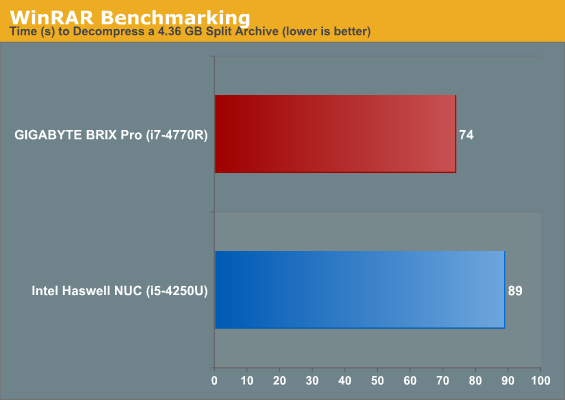
The graph below presents the internal WinRAR benchmark numbers. In this benchmark, the program takes compresses / decompresses random data in the RAM. This is a test of the CPU power as well as the DRAM capabilities.
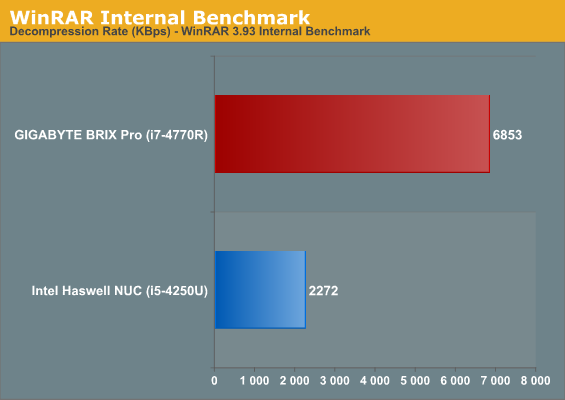
TrueCrypt Benchmark
As businesses (and even home consumers) become more security conscious, the importance of encryption can't be overstated. CPUs supporting the AES-NI instruction for accelerating the encryption and decryption processes have, till now, been the higher end SKUs. However, with Bay Trail, even the lowly Atom series has gained support for AES-NI. Both the i5-4250U and the i7-4770R have AES-NI instructions support. The TrueCrypt internal benchmark provides some interesting cryptography-related numbers to ponder. In the graph below, we can get an idea of how fast a TrueCrypt volume would behave in the two different systems.
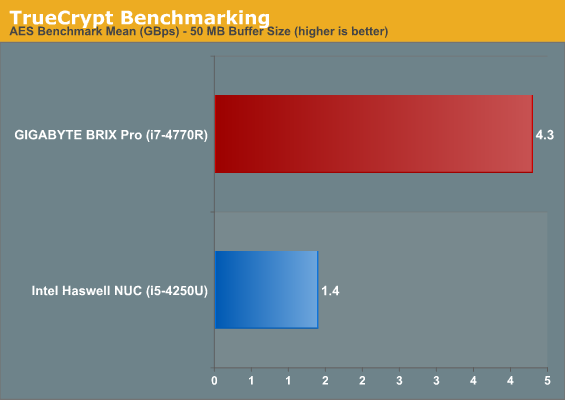
Agisoft PhotoScan
Agisoft PhotoScan is a commercial program that converts 2D images into 3D point maps, meshes and textures. The program designers sent us a command line version in order to evaluate the efficiency of various systems that go under our review scanner. The command line version has two benchmark modes, one using the CPU and the other using both the CPU and GPU (via OpenCL). The benchmark takes around 50 photographs and does four stages of computation:
Stage 1: Align Photographs
Stage 2: Build Point Cloud (capable of OpenCL acceleration)
Stage 3: Build Mesh
Stage 4: Build Textures
We record the time taken for each stage. Since various elements of the software are single threaded, others multithreaded, and some use GPUs, it is interesting to record the effects of CPU generations, speeds, number of cores, DRAM parameters and the GPU using this software.
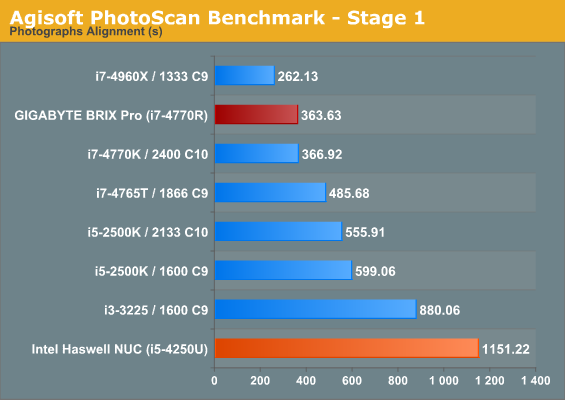
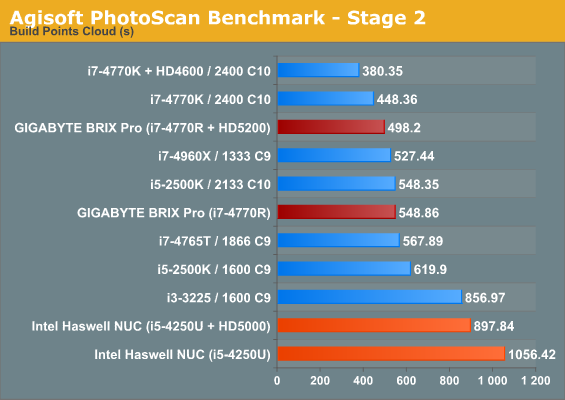

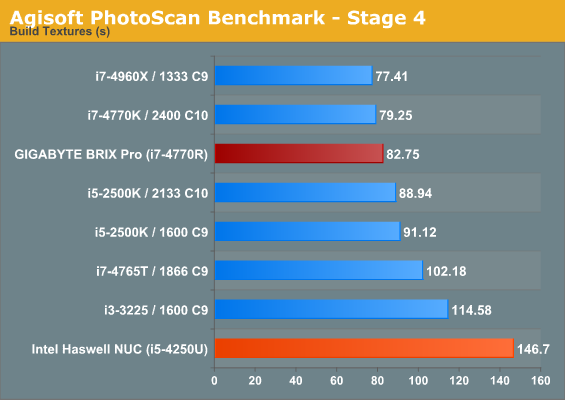
The second stage also reports the throughput rate of the CPU and GPU in million points per second. For the BRIX Pro, in the CPU only mode, we had a rate of 124.99 mp/s. Using OpenCL acceleration, the CPU and GPU had rates of 69.5 mp/s and 98.32 mp/s respectively. The corresponding numbers for the NUC were 68.36 mp/s, 20.39 mp/s and 78.59 mp/s.
Essentially a prosumer real-world test, we hope to put more of our systems under this benchmark in the future. Ian already has a large number of custom-built systems for which he will present benchmarks in his motherboard reviews.










98 Comments
View All Comments
DIYEyal - Tuesday, January 7, 2014 - link
I could use something like that for editing on the go, much smaller than any mITX system.. Much cheaper than a laptop with similar specs.. I could plug it to the hotel's TV via HDMI and get some editing done (weird configuration, I know)CharonPDX - Tuesday, January 7, 2014 - link
Re: "One of the interesting aspects in the press release was the reference to 64 MB of eDRAM on the Iris Pro HD 5200.".Apple doesn't just "imply", they outright state it: "The 15‑inch MacBook Pro has a phenomenal display — with the graphics power to match. Its fourth-generation Intel Core i7 processor features Iris Pro Graphics with 128MB of embedded memory, which accelerates processor- and graphics-intensive tasks by acting as an ultrafast cache. "
But the Retina MacBook Pro uses the mobile chip, not the desktop chip. Maybe the desktop chip only has 64 MB?
JohnHardkiss - Tuesday, January 7, 2014 - link
Interesting. It would be gold if these seemingly contradictory bits of information would be settled.Daedalus1 - Tuesday, January 7, 2014 - link
I have been waiting for a NUC or similar to come out with the 5200 Iris Pro graphics for some time. At last. And then disappointment, it only supports 2 monitors not 3.Oh well maybe I just have to go the AsRock mini iTX route after all.
Daedalus
kgh00007 - Tuesday, January 7, 2014 - link
Great, I've been waiting for you guys to get a hold if one of these, I'm looking forward to part 2!I would also like to request a 1080p gaming benchmark, at low or medium details, this thing will likely be connected to a 1080p HDTV afterall, that's what interests me the most!
And maybe a look at the preformance difference between 8GB and 16GB RAM configurations if any!
ryrynz - Tuesday, January 7, 2014 - link
I think you could just look up any review of the difference between 8 and 16, there's not much.. which is why I haven't bothered moving to 16.DarkXale - Wednesday, January 8, 2014 - link
RAM benefits are binary.You either have too much, or too little. In the case of games its generally an easy answer; unless you're at 4GB, or rare cases 6GB, you have too much. Its still exceptionally rare for a game to be 64-bit, and they are thus incapable of addressing more than 4GB. The rest is simply up to the system & background tasks.
However, its always preferable to have too much RAM - than too little. Too much generally just means that you ended up paying a bit more - too little means extreme swapping, utterly annihilating performance.
8GB as such is the sweet spot, because its a level which is difficult to reach without the use of specific software - but cheap enough that going down to the 6GB or 4GB levels saves almost no money on a home-build setup.
lco45 - Monday, January 20, 2014 - link
Nicely put.8steve8 - Tuesday, January 7, 2014 - link
1. gigabytes own specs list 3200x2000 @ 60 Hz the max resolution on the displayport...why, it's DP 1.2? This would exclude it for use with all the new 4k LCD's coming our soon.
2. a few gaming benchmarks would be appreciated... part of the allure of this is that it's a tiny workstation that can also kind of play games.
Samus - Tuesday, January 7, 2014 - link
Wow this little thing is amazing.